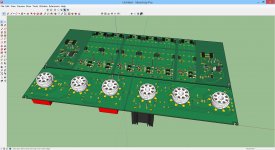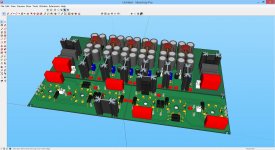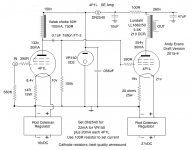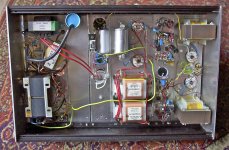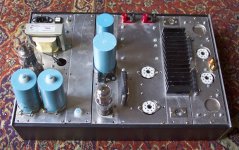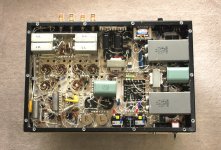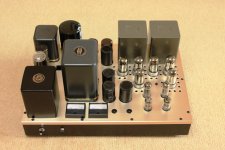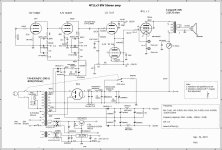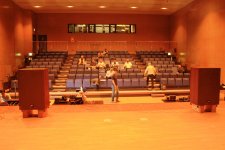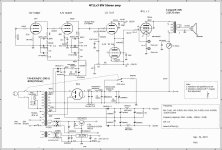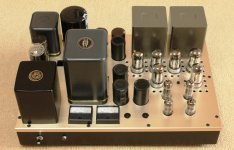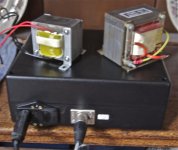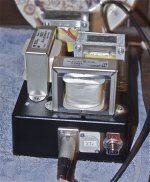My usual amp is a PSE 4P1L amp. 4P1L into LL1660/18mA into parallel 4P1L with LL1620/80mA OPT. All filament bias. I'm pretty happy with it and it's lasted 3 years in my system.
On a whim I threw together some parts I had left over from other projects and produced a SE 4P1L with 4P1L input, choke loaded with a teflon FT-3 coupling cap and a LL1682/50mA OPT. I didn't expect much out of this, and for a start thought it would never drive my Alpair 10s. I thought the primary impedance of the LL1682 at 5K into 5R was too high. I thought the Valab 50H plate choke was going to be pretty average. I wasn't expecting the sound that came out of the speakers.
Well, this is as good an amp as anything I've ever built - all the usual suspects like 300b and 2a3 SETs and so on. I'm just amazed. Very detailed indeed and effortlessly smooth, with very good timbre to acoustic instruments, voice and piano. This is a much cheaper version of a 45 amp, with cheap and easily sourced tubes. I would not be surprised if it sounded just as good as most 45 designs.
Here's the schematic. The parts are relatively cheap for an amp like this, though the PSU and filament supplies are quite complex.
On a whim I threw together some parts I had left over from other projects and produced a SE 4P1L with 4P1L input, choke loaded with a teflon FT-3 coupling cap and a LL1682/50mA OPT. I didn't expect much out of this, and for a start thought it would never drive my Alpair 10s. I thought the primary impedance of the LL1682 at 5K into 5R was too high. I thought the Valab 50H plate choke was going to be pretty average. I wasn't expecting the sound that came out of the speakers.
Well, this is as good an amp as anything I've ever built - all the usual suspects like 300b and 2a3 SETs and so on. I'm just amazed. Very detailed indeed and effortlessly smooth, with very good timbre to acoustic instruments, voice and piano. This is a much cheaper version of a 45 amp, with cheap and easily sourced tubes. I would not be surprised if it sounded just as good as most 45 designs.
Here's the schematic. The parts are relatively cheap for an amp like this, though the PSU and filament supplies are quite complex.
Attachments
@andyevans
I agree with you, PSU and filament suppliesssss are more complex then the complete amplifier.
I will try this weekend to finish the complete 3D construction with the six toroid transformers for the supplies (located in the case) and the two external toroid OT: target = easy to build (need also a good 3D model for the Lundahl transformer).
I´m working today the low power amplifier with no R no C from Franck Blöhbaum: I´m not sure if I will use AC or DC filament supplies and purely tube HV supplies or Maida Regulator?! But the supplies are in a separate case...
Do you know a source for sexy meters?
I agree with you, PSU and filament suppliesssss are more complex then the complete amplifier.
I will try this weekend to finish the complete 3D construction with the six toroid transformers for the supplies (located in the case) and the two external toroid OT: target = easy to build (need also a good 3D model for the Lundahl transformer).
I´m working today the low power amplifier with no R no C from Franck Blöhbaum: I´m not sure if I will use AC or DC filament supplies and purely tube HV supplies or Maida Regulator?! But the supplies are in a separate case...
Do you know a source for sexy meters?
my 4P1L used CRC filtering on the filaments,
cathode resistor bias.....very quiet build, no hum, no hiss, you have to
put your ears close to the speakers to hear something, but even that is minimal...
these Russian tubes can give the 2A3/300b a run for the money...
shown below on the right is the filament supply board with a 317 regulator,
in the final iteration, i ditched the regulator for a simple resistor...
cathode resistor bias.....very quiet build, no hum, no hiss, you have to
put your ears close to the speakers to hear something, but even that is minimal...
these Russian tubes can give the 2A3/300b a run for the money...
shown below on the right is the filament supply board with a 317 regulator,
in the final iteration, i ditched the regulator for a simple resistor...
An externally hosted image should be here but it was not working when we last tested it.
Hi AJT,
Your circuit description is VERY interesting since I can't afford the Coleman filament regulator.
Would be great to see how you connect everything (more specificaly the filaments), I have never worked with DH tubes but I've got a few 4P1L ready to be put to good use.
Thanks in advance,
Eric
Your circuit description is VERY interesting since I can't afford the Coleman filament regulator.
Would be great to see how you connect everything (more specificaly the filaments), I have never worked with DH tubes but I've got a few 4P1L ready to be put to good use.
Thanks in advance,
Eric
Here's my layout inside. I always use a modular construction based on 19" rack parts, 2U. Top plates are 100, 70 or 50mm. I frequently swap and alter the plates about between projects, so there are often some unexpected holes! But it means I don't have to breadboard and come up with finished amps quite quickly.
Attachments
Last edited:
Awesome, thanks.
fyi, i design and build all irons used in all of my amps.....
Here's my layout inside. I always use a modular construction based on 19" rack parts, 2U. Top plates are 100, 70 or 50mm. I frequently swap and alter the plates about between projects, so there are often some unexpected holes! But it means I don't have to breadboard and come up with finished amps quite quickly.
I am pleased to inform you that my project of 4P1L x 3 PSE amp has been completed in the wake of one and half years of trial phase.
I am fully satisfied of the outcome in sound and its figures measured, especially at the low distortion (THD) level and its low residual noise for No NFB amp.
I will bring this 4P1L amp to the 28th Toyama Craft Audio Exhibition to be held in Toyama city on October 3rd, at where there are exhibitions of PX-25 SE, 300B SE, 50 SE, 4P1Lx3 PSE , 211 SE and 46PP amps. So I would be in a position to hear voices to my amp brought from participants..
Hiro
Attachments
Hello Michimori San!
Your built is awesome and refined!
Surprise me that low power amp could drive that B&W 802 of your's!
Beleives you'll be competing with heavyweights like Machida and Kiyohara San.
Enjoy your fruit and wishing you great possitive responses!
Your built is awesome and refined!
Surprise me that low power amp could drive that B&W 802 of your's!
Beleives you'll be competing with heavyweights like Machida and Kiyohara San.
Enjoy your fruit and wishing you great possitive responses!
Last edited:
I am pleased to inform you that my project of 4P1L x 3 PSE amp has been completed in the wake of one and half years of trial phase.
I am fully satisfied of the outcome in sound and its figures measured, especially at the low distortion (THD) level and its low residual noise for No NFB amp.
I will bring this 4P1L amp to the 28th Toyama Craft Audio Exhibition to be held in Toyama city on October 3rd, at where there are exhibitions of PX-25 SE, 300B SE, 50 SE, 4P1Lx3 PSE , 211 SE and 46PP amps. So I would be in a position to hear voices to my amp brought from participants..
Hiro
Congratulations! Great amp!
4P1Lx3 PSE(8W)
I have received a summary report of the 28th Toyama craft Audio club
Exhibition held on October 3rd and there were about 70 people gathered.
Following amps were brought in :
• PX-25 SE,
• VT-25 SE(4.5W),
• 300B SE(8W),
• UV-211 SE(28W),
• 4P1Lx3 PSE(8W),
• C-585 SE
• KT-150 SE.
Each was given 30 minutes for playing CDs, analog records or PC audio including one common source, and this exhibition was not primary intended for making ranking rather to hearing straight comments from the attendants later through summary report.
The hole was 180 seats with good S/N environment, and its reverberation time is 0.8 Sec.
The Loud speaker was of Altec-620A(100dB).
Feed back from the audience to the 4P1Lx3 PSE amp of mine are of favorable one in general and followings are in details.
• The sound was quiet visible one in front stage, had a superb detail sustaining high dynamic range.
• Beautiful and dynamic sounding.
• Today`s best sound, especially good balancing in high region and low end energy for the SE amp.
• Quiet, clean and fancy sound, and some expressed to hear longer with this amp.
• Good definition and had a contour of the sound.
• Fantastic and dynamics especially in vocal.
• Best sounding among candidates of 7.
• Good in balance
• Wonderful in low and mid ranges, but highs was a little rough.
Hiro
I am pleased to inform you that my project of 4P1L x 3 PSE amp has been completed in the wake of one and half years of trial phase.
I am fully satisfied of the outcome in sound and its figures measured, especially at the low distortion (THD) level and its low residual noise for No NFB amp.
I will bring this 4P1L amp to the 28th Toyama Craft Audio Exhibition to be held in Toyama city on October 3rd, at where there are exhibitions of PX-25 SE, 300B SE, 50 SE, 4P1Lx3 PSE , 211 SE and 46PP amps. So I would be in a position to hear voices to my amp brought from participants..
Hiro
I have received a summary report of the 28th Toyama craft Audio club
Exhibition held on October 3rd and there were about 70 people gathered.
Following amps were brought in :
• PX-25 SE,
• VT-25 SE(4.5W),
• 300B SE(8W),
• UV-211 SE(28W),
• 4P1Lx3 PSE(8W),
• C-585 SE
• KT-150 SE.
Each was given 30 minutes for playing CDs, analog records or PC audio including one common source, and this exhibition was not primary intended for making ranking rather to hearing straight comments from the attendants later through summary report.
The hole was 180 seats with good S/N environment, and its reverberation time is 0.8 Sec.
The Loud speaker was of Altec-620A(100dB).
Feed back from the audience to the 4P1Lx3 PSE amp of mine are of favorable one in general and followings are in details.
• The sound was quiet visible one in front stage, had a superb detail sustaining high dynamic range.
• Beautiful and dynamic sounding.
• Today`s best sound, especially good balancing in high region and low end energy for the SE amp.
• Quiet, clean and fancy sound, and some expressed to hear longer with this amp.
• Good definition and had a contour of the sound.
• Fantastic and dynamics especially in vocal.
• Best sounding among candidates of 7.
• Good in balance
• Wonderful in low and mid ranges, but highs was a little rough.
Hiro
Attachments
Thanks vt4c, the hole in Toyama and Altec-620A created the best sound.
Unfortunately, I cannot hear the same grade of sound at my listening room.
Hiro
"Unfortunately" the listening room and the recordings are the most important elements in the chain. If one of these two is not good enough the sound will not be good enough. One might also be mistaken in addressing the faults blaming amplifier, source or speakers.
One can tweak speakers or amps to get a more enjoyable sound but I don't think will ever get the best out them without a proper room and proper source. It might sound trivial but this is actually the real problem most people have in their homes....
"Unfortunately" the listening room and the recordings are the most important elements in the chain. If one of these two is not good enough the sound will not be good enough. One might also be mistaken in addressing the faults blaming amplifier, source or speakers.
One can tweak speakers or amps to get a more enjoyable sound but I don't think will ever get the best out them without a proper room and proper source. It might sound trivial but this is actually the real problem most people have in their homes....
+1
I've been working on filament supplies for my 4P1L SE, which is now 4P1L into 4P1L. For the input stage I use a 150v voltage reg. tube feeding a Hammond 126B as plate choke, and at around 25mA for the 4P1L that gives a cathode resistor of 13 ohms and a bias of 8.5v. Add 2v for the filament and you have 10.5v, and add 6.5v for Rod's reg (Ver 2) and you get 17v supply.
Previously I achieved that with an 18v toroid in cap input followed by a Hammond 159ZC 60mH choke. The new supply is a 25v EI transformer and a 280mH choke in choke input, LCRC. With a 6.8R dropper resistor this gives me the required 17v.
Sound is clearer and more detailed - an audible improvement. So the supply does matter. Thomas Mayer is a big believer in chokes in the filament supply, and I can only agree with him - it's worth it. For a single 4P1L at 640mA this is overkill - a 60VA transformer and a 2.7A choke. But hey, it works.....
For the output section I have 18.5v bias and a 28.5R resistor. So Rod's reg needs to feed 20.5v and so supply is 27v. Here I used the same 25v transformer, with cap input, hammond chokes and an 8.2R dropper resistor. CLCRC. This sounds better than the Thurlby Thandar bench supplies I was using to set it up, but next step will be choke input for that as well.
Photos show a) the input supply for 2 channels - the 2 big chokes do actually fit in! The connector is a 4-pole XLR. And the other photo b) shows the supply to the 4P1L outputs with the Hammond 159ZC 60mH chokes.
Previously I achieved that with an 18v toroid in cap input followed by a Hammond 159ZC 60mH choke. The new supply is a 25v EI transformer and a 280mH choke in choke input, LCRC. With a 6.8R dropper resistor this gives me the required 17v.
Sound is clearer and more detailed - an audible improvement. So the supply does matter. Thomas Mayer is a big believer in chokes in the filament supply, and I can only agree with him - it's worth it. For a single 4P1L at 640mA this is overkill - a 60VA transformer and a 2.7A choke. But hey, it works.....
For the output section I have 18.5v bias and a 28.5R resistor. So Rod's reg needs to feed 20.5v and so supply is 27v. Here I used the same 25v transformer, with cap input, hammond chokes and an 8.2R dropper resistor. CLCRC. This sounds better than the Thurlby Thandar bench supplies I was using to set it up, but next step will be choke input for that as well.
Photos show a) the input supply for 2 channels - the 2 big chokes do actually fit in! The connector is a 4-pole XLR. And the other photo b) shows the supply to the 4P1L outputs with the Hammond 159ZC 60mH chokes.
Attachments
Last edited:
- Home
- Amplifiers
- Tubes / Valves
- One more 4P1L SE
